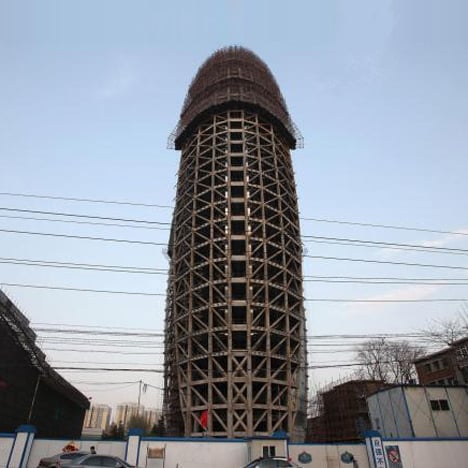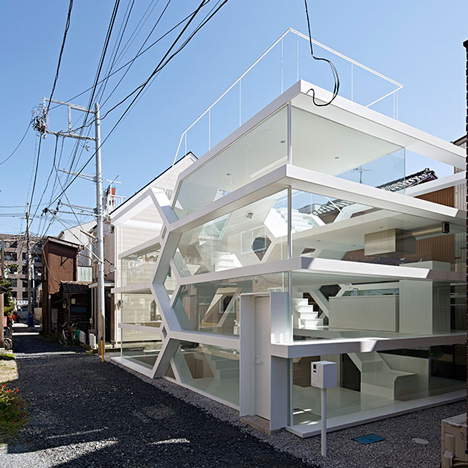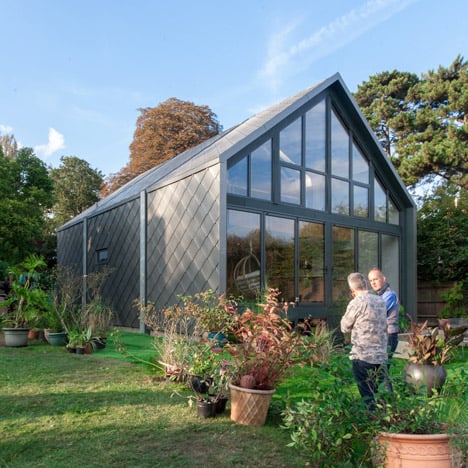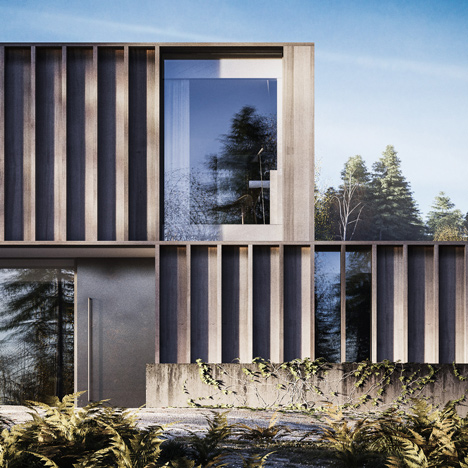
"I personally quite like Rem's Pants... as for the giant penis, why not?"
Comments update: architecture dominated the discussions on Dezeen this week, spurred on in part by the president of China who declared that he wanted "no more weird architecture" in his country.
Weird architecture? Chinese president Xi Jinping used a two hour speech on the state of art in his country to call for an end to the "weird architecture" that has sprung up during the construction boom, singling out projects like the Rem Koolhaas-designed CCTV headquarters in Beijing that has been compared to a giant pair of pants.
His comments appeared on the website of Chinese state newspaper the People's Daily – whose own new headquarters building (top image) came under fire last year after being compared to a giant penis.
"Thanks Dezeen. I just spat my tea out reading this story. That is a remarkable penis," wrote one commenter calling themselves Penis Envy.
"I personally quite like Rem's Pants. As for the giant penis, why not? Perhaps fascist China is wary of the form manifest self-expression?" added another commenter, under the pen-name What does weird even mean?
Some approached the debate with a more serious tone. "The last thing China needs is another top-down dressing down of creativity in a nation that has imitation as its core ethos, that it's the best form of flattery," wrote spadestick. "Instead of picking on icons, why not pick on the myriad of ghost cities filled with banal developer schlock for commercial gain?" Read the comments on this story »

Computerised architecture: London designer Matthew Plummer Fernandez claimed that software packages have become so popular they are affecting the way buildings look, and called on architects to start developing their own code rather that using "off-the-shelf" solutions. Some readers felt his comments were behind the times.
"Even just a very superficial look at the work developing in architecture over the past 10 years in certain architecture circles would reveal that his critique, while spot on, it is at least a decade late," wrote Matters. "As early as 25 years ago boutique researchers were doing just what he suggests. Maybe it isn't widespread within the discipline today, but is that what we should really be addressing?"
But Stephanie felt the fault lay in lack of education. "I definitely fell into the trap at school of needing a quick, interesting-looking diagram/model, which things like Voronoi produced without much hassle (especially for people with limited coding knowledge).
"I think the problem was that we were never taught how to work with computational design – if you didn't already have a background knowledge of programming, you took what you could get, and that usually resulted in the 'marriage' of interface and visual language described above."
"One look at the huge amount of plug-ins available for Grasshopper should be enough to realise that architects and designers have been developing their own code and building their own tools for years," pointed out Katja.
"In my opinion, the problem is a different one. It is not that architects and designers are not appropriating the new tools or coding their own. It is their obsession with them at times and their using parametric design for its own sake rather than to support a sustainable and integrated building design concept." Read the comments on this story »

Privacy issues: a maze-like Japanese house with completely transparent walls raised a few eyebrows, quickly becoming one of our most commented-on stories of the week.
"Looks like split-level hell," wrote Jon Jorgensen, one of a number who were less than impressed by the design. Su Vin had more practical concerns, asking "where do they have sex?"
Rafael Reyes was one of a number who saw some classic architectural references in the project. "Ok so obviously this house is unliveable for anyone but exhibitionists, but I still find the project really very interesting," he wrote. "It's the love child of Domino House, Farnsworth House and Villa Müller refined with that quirky elegance of Japanese architecture."
"Someone still believes in Corbusier. This is an excellent example of the transparency our lives provide via government eavesdropping. We might as well all be living in glass houses," added The Liberty Disciple. "Practically, this is a nightmare. Cleaning, insulating, privacy, security, and sound are virtually unthought of. It is a fun study, and likely a costly one."
Sam said that the purity of the design wasn't sustainable: "I saw pictures of owner putting up curtain which totally defeats the original intended aesthetic." Read the comments on this story »

Floating house: the UK's first "amphibious house", designed to float on rising floodwaters like a boat in a dock, is being built for a couple who wanted to live on an island in the middle of the River Thames. Readers liked the idea, but had a few concerns about its affordability and practicality.
"And the Lord said to Noah, "Go into the ark and watch the neighbours suffer"," wrote Flood Victim. "Love the idea but it needs to be cheaper. It's a fantastic solution to our recent troubles in the UK."
"Where is the front door? How do you get in and out? Do you get in depending on the level of water?" asked JDM.
Ralph Kent was one of a number who had questions about silt deposits left behind by floodwaters. "I'm guessing they have to artificially float the house and periodically 'vacuum' the trough out using some sort of system like a pool filtration system on a hose?" he wrote. "But I would be interested to know what the actual solution is, and how frequently they need to do this." Read the comments on this story »

Virtual values: architect Henry Goss told Dezeen that photo-realistic visuals had helped design his latest project – a family home in Hertfordshire, England, which is also the first output from the renderings studio he recently launched with fellow artist Peter Guthrie.
"Who needs reality when we have hyper-realistic renderings such as these?" asked Dreamer. "I think it's time I purchased Google Glass and sat in my sh*tty flat in London, looking out to the beautiful countryside from an imagined mansion with my beautiful wife who goes by the name of Scarlett Johansson."
But Strom Architects thought that viewers impressed by the visuals might be missing the point. "Nevermind the CGI; it's a good piece of architecture too," wrote the architect. Read the comments on this story »